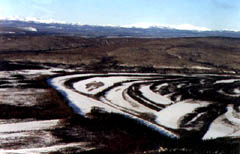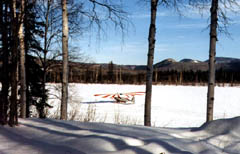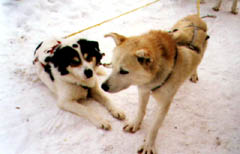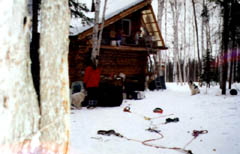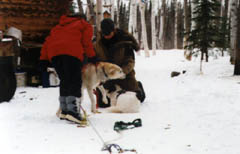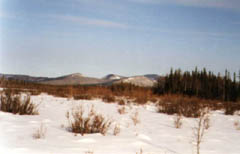Imagine flying into this vast wilderness and learn how to run a dog team. Get to know a part of this country up close. See it all from the back of a dog sled running frozen rivers and historic gold rush trails, rugged trapline trails, or travel to some back country, natural hot springs. We'll take you for a moonlit ride listening to wolves howl in the distance, with the Auroras dancing overhead.
Your plane lands and you are ready to meet your traveling partners: the dogs. Pictured here is our friend Brad's plane. They like to make a yearly visit to the homestead in March. They bring all sorts of exotic fruits and vegetables that make my mouth water: grapes, mangos, papaya, asparagus, even bell peppers are an unusually wonderful treat. Our winter landing strip is complete with a wind sock to indicate wind direction.
Here the lead dogs are at the front of the pack. They are the most loyal and eager-to-please dogs. They have to know the commands "gee" and "haw". "Gee" means turn or veer right. "Haw" means turn or veer left. Some times if we are running on a road or a wide trail Bill will say, "Over gee" or "Over haw" if the dogs need to change sides of the trail. We have trained our dogs to "whoa" and sit. This is very useful for Bill out on the trapline where he hops off the sled to bait a trap or retrieve an animal. Our dogs know better than to run off without him. Now that I've said this I've jinxed him! I can't say that it hasn't happened-the dogs running off without him, but we take a lot of extra time teaching the dogs to listen to our commands.
Lay out your harnesses and gang line. Begin harnessing the dogs. Four or five dog teams are a good size for novice mushers. With experience you can hook up more dogs for greater speed, power, and endurance. Bill usually runs a team of twelve that freight supplies between the homestead and Manley. It isn't unusual for Bill to load up a sled with 500 pounds for dog food or bulk food for us. It is hard work but the dogs are born to run. They get depressed when they can't run. Bill and the dogs mourn the coming of Spring, while I rejoice it.
The procedure for harnessing a dog is a bit like controlled mayhem or like dressing a two-year-old who is throwing a tantrum. The dogs are unhooked from their chains and walked to the gangline, one at a time. All the dogs get excited by the activities and the prospect of going for a run. The whole dog lot barks in anticipation. Once a dog is positioned at the gangline you have to quickly stuff the dogs head through the harness so they can't get away. Then you pull their legs through and secure the neckline so the dogs can't turn around and tangle in the gangline. The lead dogs are hooked up first. It is their job to keep the line taut. Some of the more hyper dogs are left to the end of the hook up process. They are the dogs that are more likely to chew the line. Pictured here is Bill and Nicki, a client from England, hooking up a team for a day trip.
Bill also makes long distance trips between the homestead and Fairbanks. It is about 100 miles across Minto Flats. It takes him 2 full days of mushing and he generally stops every 4, 5 or 6 hours to let the dogs rest. Bill feeds and waters them during the breaks. The dogs settle right down and sleep. It is harder for Bill to sleep. He curls up in the sled but is never fully rested while on a long trip, but he gets a euphoria and natural high being out in the country. It allows for lots of time to enjoy the view along the way. Being on the back of a dog sled you see everything that the land has to offer like animal tracks or local geography. Some of the tracks you could see include: wolf, wolverine, otter, mink, marten, fox. Some of the geography you could see are sand dunes left from the last ice age, old abandoned and some occupied roadhouses, old homesteads long since lived in, but still carrying the Alaskan frontier spirit. |
Wood's Alaskan Adventures
woodak@mosquitonet.com

